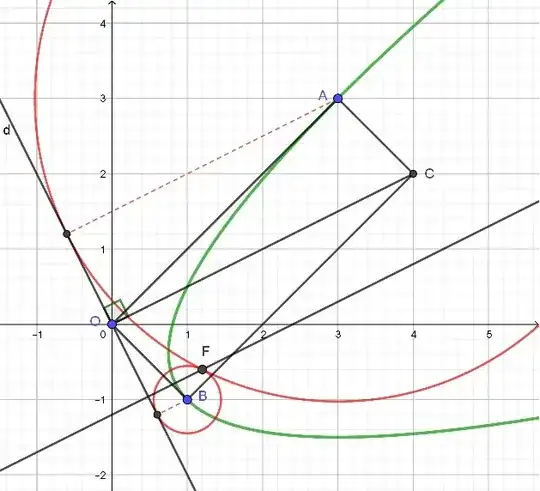The most general form of a parabola is $$Ax^2+Bxy + Cy^2 + Dx +Ey +F=0$$
where $$B^2 = 4AC \tag{1}$$.
Letting $(x,y)=(3,3)$, we get $$9A + 9B + 9C + 3D + 3E + F = 0 \tag{2}$$
Letting $(x,y)=(1, -1)$, we get $$A - B + C + D - E + F = 0 \tag{3}$$
\begin{align}
Ax^2+Bxy + Cy^2 + Dx +Ey +F=0
&\implies 2Ax + By + Bxy' + 2Cyy' + D + Ey' = 0 \\
&\implies (Bx + 2Cy + E)y' + (2Ax + By + D) = 0
\end{align}
Letting $(x,y,y') = (3,3,1)$, we get $(3B + 6C + E) + (6A + 3B + D) = 0$,
which implies $$6A + 6B + 6C + D + E = 0 \tag{4}$$
Letting $(x,y,y') = (1,-1,-1)$, we get $-(B - 2C + E) + (2A - B + D) = 0$,
which implies $$2A - 2B + 2C + D - E = 0\tag{5}$$
Solving equations $(1)$ through $(5)$ and letting $A=1$, we get
$$(A,B,C,D,E,F) = (1, -4, 4, -12, 6, 9)$$
So, the equation of the parabola becomes
$$x^2 - 4xy + 4y^2 - 12x + 6y + 9 = 0$$
Added because of something that I found out later.
If $A=0$, then $B^2=4AC$ implies $B=0$ and the equation becomes $Cy^2 + Dx +Ey +F=0$.
If $A \ne 0$, then $A < 0$ implies
$$(-A)x^2 +(-B)xy + (-C)y^2 + (-D)x + (-E)y + (-F) = 0$$
and $B^2=4AC \iff (-B)^2 = 4(-A)(-C)$
So we may as well assume that $A = a^2 > 0$. Then
\begin{align}
Ax^2 + Bxy + Cy^2
&= \dfrac{1}{4A}(4Ax^2 + 4ABxy + B^2y^2) \\
&= \dfrac{1}{4A}(2Ax+By)^2 \\
&= (ax+by)^2 \\
\end{align}
where $b = \dfrac{B}{2a}$.
So we can write the most general form of a parabola as $$(ax + by)^2 + Dx +Ey +F=0$$
We can now argue much as I did above and get the same answer without being annoyed by the nonlinear equation $B^2 = 4AC$.
